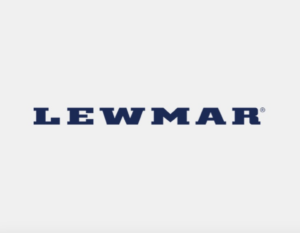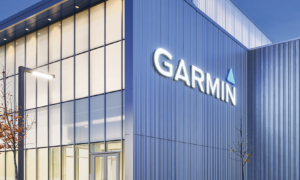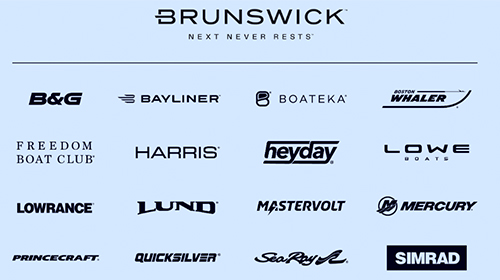When it comes to marine propulsion, much has changed in the past 60 years. The sterndrive was a new idea. A 100-hp Kiekhaefer Mercury was the most powerful outboard money could buy. A diesel inboard often belched soot. By comparison, today’s engines are cleaner, quieter and more efficient, and would be unimaginably powerful to a boater in the early 1960s.
Two factors have influenced the evolution of marine propulsion: intense competition among key players, and exhaust emissions regulations. The technology created to control auto emissions has enabled the development of today’s gasoline and diesel marine engines. In the future, the investment auto manufacturers make in hybrid and electric vehicles will likely trickle down to marine.
As we anticipate that leap forward, let’s take a look back at 60 years of marine propulsion and the developments that have shaped today’s powerboating experience.
1964 – Kiekhaefer MerCruiser II
The modern sterndrive was introduced as the Volvo Penta Aquamatic 100 at the 1959 New York Boat Show. It paired an inboard 100-hp engine with a transom-mounted outdrive that was steerable and tilted “to combine inboard efficiency and safety with outboard flexibility and speed.” The Aquamatic also had 30 more horses than Mercury offered in an outboard. Kiekhaefer Mercury countered in 1961 with the MerCruiser sterndrive, packaged with marinized Chevrolet engines at 120 and 140 hp. In 1964, a more robust MerCruiser II drive was offered with familiar American engines rated up to 310 hp — three times the power of any contemporary outboard.
1982 Volvo Penta Duoprop
Borrowing an idea from the torpedo, the Volvo Penta Duoprop sterndrive had contra-rotating propellers on a common shaft, first for diesel engines and later with gasoline. Twin props had more blade area and thrust than a single prop, with better control at low speeds, especially in reverse. They also improved performance for larger cruising boats. In 1995, MerCruiser introduced its twin-prop Bravo Three drive. Duoprop and Bravo Three remain on the market, and Suzuki and Mercury have contra-rotating props on their most-powerful outboards.
1990 – Mercury HP525SC
Following Brunswick Corp.’s acquisition of Kiekhaefer Aeromarine, Fred Kiekhaefer led an effort to transition Mercury Hi-Performance from racing into producing engines for high-performance pleasure boats, a segment booming in the wake of Miami Vice’s popularity. One early product was the MerCruiser Hi-Performance HP525SC, the first mass-produced, supercharged and warrantied marine engine. The 7.4-liter V-8 was rated at 490 hp on 92-octane pump gasoline. By 1992, Hi-Performance would add 600- and 750-hp supercharged engines.
1991 – Honda BF45
Through the 1980s, all popular outboards used a 2-stroke powerhead burning gas-and-oil fuel, a combination that produced tremendous hydrocarbon emissions. In the early 1990s, outboard manufacturers were given about 10 years’ notice that emissions regulations would be forthcoming. This raised debate inside engine companies.
The premise of the outboard was that it was lightweight for its power; manufacturers could not imagine how a 4-stroke engine would ever be light enough. At Mercury and OMC, there were factories with teams of engineers tooled up to manufacture 2-stroke engines. But when Honda introduced its 45-hp 4-stroke in 1991, it got attention from other manufacturers. The 3-cylinder, 808cc BF45 weighed about 200 pounds and was much smoother, quieter and more fuel efficient than contemporary 2-strokes. Honda followed with a BF90 model in 1998, pitching its 4-stroke motors as “power in tune with nature.” They were a hit with freshwater anglers who could troll for hours without inhaling 2-stroke exhaust.
1995 -Common Rail
Diesel Fuel Injection
A desire to reduce exhaust emissions in auto and truck diesel engines revived interest in an old idea: the common rail injection system. The advent of modern electronic engine controls made it possible to replace traditional mechanical diesel injectors with a hollow rail of highly pressurized fuel running the length of the cylinder head. The rail feeds each individual fuel injector, which opens and closes under control by the engine computer. Fuel delivery can thus be optimized for engine speed and load, unlike with mechanical injectors, which perform best at full throttle. The high-pressure common rail system atomizes fuel into fine particles that ignite easily and burn completely, significantly reducing emissions.
Nippon-Denso introduced the first common rail system for truck engines in 1995, and the technology soon appeared on marine diesels from Volvo Penta, Caterpillar, Cummins and others. The system was further refined with the introduction of pulse injectors, which deliver fuel in multiple bursts in each cycle.
1998 – Joystick Control
The joystick has been called one of the 20th century’s most distinctive contributions to the interface between people and machines. It was initially related to flight, but many manufacturers, including Hinckley Yachts, saw that it could be used for other things. In 1998, the builder introduced the JetStick, a joystick that simultaneously integrated control of the boat’s main jetdrive and side thrusters. With it, the driver could rotate the boat almost within its own length, or slide it directly sideways to snug up to a dock.
In 2005, the era of digital joystick controls arrived with the introduction of the Volvo Penta IPS. In 2007, the Cummins MerCruiser Zeus pod drive was introduced with all-digital controls that included the SmartCraft joystick docking system. IPS and Zeus achieved the level of close-quarters maneuverability offered by the Hinckley JetStick, but without the use of thrusters.
Digital steering and throttle/shift control made the joystick possible. With constant refinement by Volvo Penta, Mercury Marine and Dometic’s Seastar Solutions, joystick control is now available for all steerable propulsion systems. Linking digital steering with GPS has enabled station-holding features and digital autopilot systems. Today, we are on the cusp of workable autonomous docking and avoidance systems made possible by being able to independently control the steering, shifting and throttle of multiple engines.
1996 – 2-Stroke Direct Fuel Injection
Doubting the viability of a large 4-stroke outboard, and stuck in the prevailing 2-stroke culture, Mercury Marine and OMC pursued a low-emissions 2-stroke solution: direct fuel injection. The DFI system would inject atomized fuel directly into the combustion chamber, timed electronically to prevent unburned fuel from escaping through the exhaust port, which is the main source of hydrocarbon emissions. The Mercury OptiMax 200 with DFI debuted in early 1996, and Evinrude and Johnson models with Ficht RAM DFI came to market in 1997. Yamaha would introduce its HPDI (high pressure direct injection) DFI 2-stroke models in 2000. Each company’s DFI technology cut emissions by about 30%, enough to meet the government’s 2006 emissions regulations, and improved fuel efficiency by 30%. Both the Ficht and OptiMax engines experienced early technical issues. Those afflicting OMC were more dramatic and contributed to the 2000 bankruptcy of the company. BRP acquired the Johnson and Evinrude brands and technology, and re-engineered the DFI system as Evinrude E-TEC.

Citing near-complete customer preference for 4-strokes, Yamaha dropped its HPDI 2-stroke outboards in 2015. Mercury replaced its last OptiMax Pro XS models with V-6 and V-8 4-strokes in 2018. BRP persisted on the 2-stroke track, introducing Evinrude G2 engines in 2014, but after 20 years of trying to win over boaters with DFI technology, BRP discontinued Evinrude production in 2020.
1999 – Yamaha F115
Yamaha pushed the 4-stroke outboard further into the mainstream with the F115. It applied casting technology developed for 450cc 4-stroke motocross motorcycles to reduce powerhead weight. At 401 pounds, the F115 was 40 to 50 pounds heavier than a DFI 2-stroke, but about 70 pounds lighter than a 4-stroke Honda BF115. The Yamaha was smooth and quiet. As 4-stroke outboards became more powerful and were rigged to larger boats, the weight difference became less significant. In 2001, Yamaha introduced a V-6 F225 4-stroke that was as compact and lightweight as a 2-stroke.
2004 – Mercury Verado
Mercury placed its 4-stroke bet on the all-new, supercharged 2.6-liter Verado, and it turned out to be a winner. Originally designed to produce 275 hp, the Verado would go through five generations of development, get boosted to 400 hp, and remain in the Mercury line for 19 years, an astounding lifespan for any engine. In two decades, it earned a bulletproof reputation. The Verado also made its debut with two key features: electro-hydraulic power steering and digital controls. Its narrow profile allowed multiengine mounting on 26-inch centers, its inline 6-cylinder engine was silky smooth, and the supercharger produced impressive low-end thrust.
2005 – Volvo Penta IPS
Volvo Penta changed the inboard game in 2005 with the introduction of the Inboard Performance System (IPS), a steerable pod-drive setup designed to replace direct-drive and V-drive inboard power in twin-engine boats from about 37 to 50 feet. IPS was initially offered as a complete system with the Volvo Penta D6 diesel engine, a propulsion unit with gearbox and forward-facing contra-rotating props, drive-by-wire steering, throttle/shift controls and an information screen for the helm. Compared with traditional inboards, IPS offered reduced drag for improved efficiency and improved control at all speeds. The propulsion units were electronically steered individually to help track the boat through turns, and the dual props offered outstanding thrust control at low speeds.
2007 – Yamaha F350
When introduced, the 5.3-liter V-8 Yamaha F350 was the most powerful and, at 804 pounds, heaviest outboard ever produced. Rather than design this engine for speed, Yamaha tuned it like a locomotive, with low-end power to swing a big propeller and lift a heavy boat on plane. It produced 45% more thrust than an F250.
To prove the concept, Yamaha rigged a pair of F350s on the transom of a Grady-White 360 Express in place of the usual triple F250 outboards. The engine could replace inboard power on heavy offshore boats with a significant weight reduction, ease of maintenance and repower, and the ability to trim and tilt above the water. The inboard engine bay could be redesigned as a midcabin, mechanical room or a fishbox. Boatbuilders imagined the possibilities.
2007 – Indmar ETX/CAT
Adapting automotive exhaust catalyst technology to inboard marine engines proved challenging. A catalyst functions at high temperatures, which is not an issue when it’s exposed to the air below a vehicle, but is a potential problem in the tight confines of a boat’s engine compartment. The hot catalyst could also be destroyed if it comes in contact with water used to cool the exhaust. In addition, this type of emissions control system relies on an oxygen sensor in the exhaust that would also have to be moisture-resistant.
Indmar Products, an engine supplier to the inboard towboat segment, developed an exhaust manifold that prevented water inversion and was dry up to the catalyst. This manifold, paired with new cooler catalysts and more-robust O2 sensors developed for the auto industry, made it possible for Indmar to meet the 2008 California Air Resources Board’s Four Star-Super Ultra Low exhaust emissions rating. Today, all gas inboard and sterndrive engines are catalyzed.
2010 – Mercury Racing QC4
Mercury Racing took sterndrive performance to a new level with the Quad Cam Four Valve (QC4) 1350, a 9.0-liter twin-turbocharged V-8 mated to a new, robust M8 drive and electro-hydraulic transmission. Rather than build up an automotive engine, Mercury Racing designed a custom aluminum engine block. It had bore and stroke selected to produce massive torque and high-revving horsepower; deep-breathing double overhead cam heads with four valves per cylinder; and premium internal components. The result was reliable, race-bred power backed by a warranty and Mercury Marine service. Today, the QC4 is offered from 860 hp to a dual-calibration 1,350/1,550-hp model.

2011 – Seven Marine 557
Taking the big outboard idea to the extreme, former Mercury engineering lead Rick Davis teamed with his sons Brian and Eric, and with manufacturing specialist Sandy Ballou, to introduce the Seven Marine 557 at the 2011 Miami boat show. This was a 557-hp outboard with a supercharged GM 6.2-liter V-8 powerhead, a ZF transmission and a Selva gearcase. They presented it on the transom of an Intrepid 370 Cuddy typically powered by triple 300-hp engines, and suggested that a pair of the Seven Marine 557 outboards could replace four 300- or 350-hp engines, offer about 300 less horsepower but also weigh 668 pounds less and significantly reduce drag by placing only two gearcases in the water. Of course, the boat owner could also rig three or four Seven Marine engines on even bigger boats, which is exactly what happened. Suddenly, it seemed that there might be no limit to outboard power.
A Seven 627 would follow. In 2017, Volvo Penta acquired Seven Marine, only to shut it down in 2020, just months before the introduction of the Mercury V-12 Verado 600. In the past decade, the advent of more powerful outboards has changed the recreational boat market in North America, almost completely supplanting the sterndrive and enabling previously unimaginable performance in large center consoles, wide-beam dayboats and cruisers.
2014 – Volvo Penta Forward Drive
Volvo Penta created the Forward Drive specifically to enable wake surfing behind a sterndrive boat, an alternative to an expensive inboard towboat. The Forward Drive has contra-rotating props, is facing forward and is located below the hull, where the props are unlikely to threaten a fallen surfer. MerCruiser immediately countered with its similar Bravo Four S drive. The sterndrives could also be trimmed.
2021 – Mercury V-12 Verado 600
Mercury flexed its engineering muscle to create a clean-sheet execution of the Seven Marine concept, an outboard with massive displacement designed to produce mighty thrust to put heavy boats on plane. A 7.6-liter V-12 powerhead produces 600 hp, transmitted through a two-speed automatic transmission with a low range for hole shot and high range, paired with up to 37-pitch contra-rotating props. Instead of steering the entire outboard, only the gearcase articulates to enable 27-inch center-to-center spacing. This also provides 45 degrees of steering range to maximize low-speed control authority in joystick mode.
2022 – Rotax S Series
Not long after shutting down Evinrude, BRP revealed its Rotax S, a 115/150-hp outboard with a horizontal powerhead designed to fit below a swim platform. The 2-stroke powerhead has E-TEC DFI and is enclosed in a watertight casing. The Rotax S addresses the last objection many customers have to outboard power: that it clutters the swim platform. It’s currently available for BRP’s Manitou Max pontoons, and more powerful versions of the Rotax concept are expected.
This article was originally published in the September 2024 issue.











